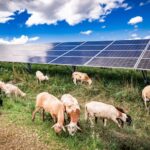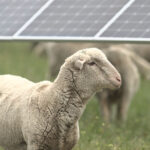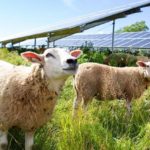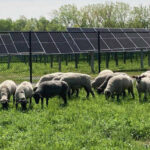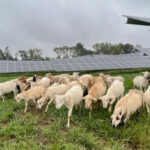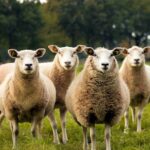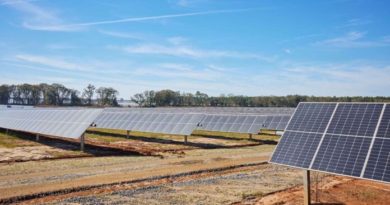Sheep Join Forces with the Solar Industry
First Solar Grazing Project in Maine Begins in Skowhegan

Michael Dennett’s sheep graze between rows in Skowhegan.
If you’re ever driving by the ReVision-built solar farm in Skowhegan, Maine, you may be surprised to see a flock of four-legged clouds nibbling grass in the shade of the solar panels. Don’t worry, these wooly friends aren’t trespassing; they’re working.
Solar grazing. Agrivoltaics. Sheep-under-solar. It has a variety of names but the concept is simple: graze livestock under solar panels, which allows solar development and agriculture to exist simultaneously. Solar grazing benefits everyone involved: the solar developer doesn’t have to use fossil fuels to mow the grass around the panels, the farmer gets paid for their services, and the sheep have a ton of vegetation to eat and guaranteed shade for that midday nap.
ReVision Energy has been a member of the American Solar Grazing Association (ASGA) for a while but only recently started to utilize solar grazing at applicable solar sites, with the help of Michael Dennett from Crescent Run Farm. Michael, a sheep farmer and 7th grade science teacher from Jefferson, Maine, has been interested in solar grazing for a while, and has closely followed the adoption of it in New York, Virginia, and the Carolinas.

Sunshine, solar panels and…sheep!? Yup, ewe read that right.
“I’ve always enjoyed raising sheep,” says Michael, “but a small flock isn’t very profitable, so the question was – how do I maintain a sizable sheep flock and make it worthwhile?” According to ASGA, Michael is the first confirmed solar grazer in Maine. He started his grazing in early May on ReVision’s 4-megawatt array in Skowhegan. The 10,500 panels making up Maine’s first multi-town solar project provide clean solar energy to the municipal buildings in Topsham, Rangeley, Dover-Foxcroft, Rockland, and Vassalboro, as well as the Vassalboro Community School. The array is owned by an affiliate of Aligned Climate Capital, an investment firm focused exclusively on clean energy and other sustainable assets.
Michael’s flock is a mix of Icelandic and Cheviot sheep that he uses for both wool and meat. It consists of 39 ewes, 1 ram, and 42 lambs. He fences them in around 2 rows of panels and lets them graze that patch for a few days before moving them down to the next 2 rows. They will eat pretty much anything, but the forage available to them under the solar arrays is comprised mostly of timothy and orchard grass, clover, and broadleaf weeds.
Sheep Love Solar

A long day of grazing calls for a nap in the solar panel shade.
It’s only been a couple of weeks but Michael is already noticing differences compared to non-solar grazing. In a normal open paddock, Michael says, the sheep are constantly searching for shade, a problem that the large solar panels have eliminated. Here, they just walk up and down the rows, laying under the panels whenever they get tired, so as a result they require a lot less water.
They are also gaining weight faster, as much as a collective 20 pounds (spread over the whole herd) each day. According to Michael, the hardworking sheep love the backsides of the panels, and when he arrives on site they can usually be found tucked up under the panels somewhere in the shade.
The sheep also provide a benefit to the solar farm and those who maintain it. Without solar grazing, the vegetation around the array would need to be maintained with traditional mowing, which is time-intensive, expensive, and typically uses fossil fuel-powered mowers. It’s also tricky to maneuver the mowers around the panels. A study by Cornell University found that nationwide, using sheep for site maintenance resulted in “2.5 times fewer labor hours than mechanical and pesticide management on site.”
Once they’re done with this array, Michael is planning to graze his flock at ReVision’s Goodwill-Hinckley solar array as well as the Streamside Community Solar Farm in Vassalboro.
“I think it’s a good thing to be doing,” Michael said. “No one has to do it but it’s the right thing to do.”
Original Source: https://www.revisionenergy.com/blogs/solar-grazing-skowhegan/




